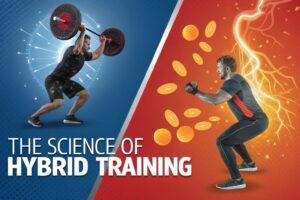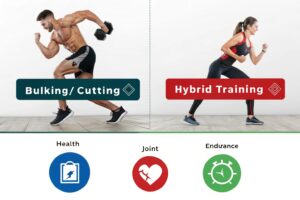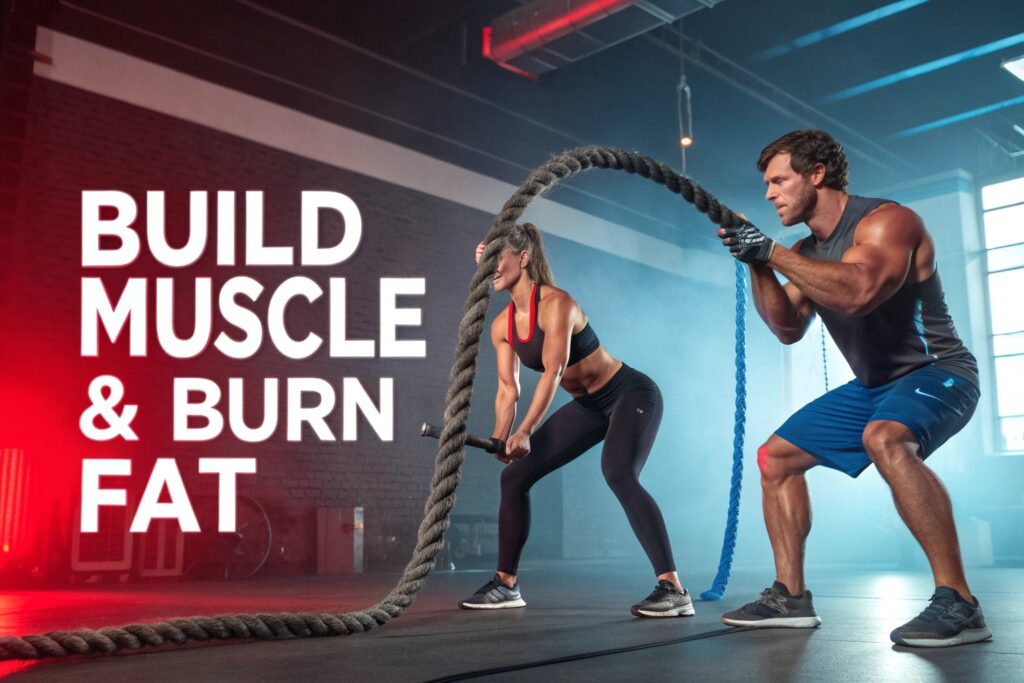Build Muscle & Burn Fat: The Ultimate Hybrid Workout – a guide that blends science, experience, and practical programming so you can sculpt lean strength while torching unwanted body‑fat. Whether you’re a beginner stepping into the gym for the first time or a seasoned athlete looking to break a plateau, this article delivers the evidence‑backed roadmap you need to achieve true body‑recomposition.
Introduction
The quest to Build Muscle & Burn Fat: The Ultimate Hybrid Workout has become the holy grail of modern fitness. Traditional training splits—solo “bulking” phases or pure cardio cardio—often leave you chasing two conflicting goals at once, resulting in sluggish progress and wasted hours. By integrating resistance training, high‑intensity interval training (HIIT), and strategic nutrition, a hybrid approach simultaneously triggers anabolic muscle growth and catabolic fat oxidation. In this post, we’ll unpack the physiological basis of hybrid training, outline a step‑by‑step program, and give you the tools to personalize the plan for your unique metabolism, schedule, and goals.
Why Hybrid Training Beats the “Either/Or” Myth (120‑150 words)
Most fitness myths stem from a misunderstanding of how the body fuels exercise. Resistance work primarily activates the phosphagen and glycolytic energy systems, prompting muscle‑protein synthesis (MPS) and encouraging hypertrophy when paired with progressive overload. Meanwhile, HIIT spikes catecholamines and elevates excess post‑exercise oxygen consumption (EPOC), prolonging calorie burn for up to 48 hours after the session. A 2019 meta‑analysis published in Sports Medicine found that combining strength and HIIT resulted in 15‑20 % greater fat‑loss and 10 % more lean‑mass gain than doing either modality alone for 12 weeks. The hybrid model capitalizes on these complementary pathways, allowing you to stay in a beneficial “anabolic window” while still keeping metabolism revved‑up like a high‑performance engine.
The Core Pillars of a Hybrid Program (120‑150 words)
A successful hybrid system rests on three foundational pillars: (1) Compound Resistance Training to recruit multiple muscle groups and generate maximal mechanical tension; (2) High‑Intensity Metabolic Conditioning that delivers short bursts of cardio and strength in a single session; and (3) Nutrition Timing that supplies sufficient protein for MPS while maintaining a modest calorie deficit for fat loss. Each pillar is interdependent—neglecting the nutritional component, for example, can blunt the hypertrophic response, while skipping metabolic conditioning may stall the calorie‑burning advantage. By balancing these elements, you create a self‑reinforcing loop: stronger muscles improve HIIT performance, and improved cardiovascular fitness speeds recovery between lifts, ultimately leading to faster, sustainable body‑recomposition.
Section 2: Understanding the Science Behind Hybrid Training

The Hormonal Dance: Testosterone, Growth Hormone, and Cortisol
Resistance training spikes testosterone and growth hormone (GH) within the first 30 minutes post‑workout, hormones that are critical for muscle‑protein synthesis. Conversely, HIIT induces a sharp but brief increase in catecholamines (epinephrine and norepinephrine) and GH, further amplifying lipolysis—the breakdown of stored fat. Research from the Journal of Strength and Conditioning Research (2021) demonstrated that combined protocols produced a 25 % higher acute GH response than resistance alone, translating into more efficient fat mobilization without compromising muscle growth. However, excessive volume or poor recovery can elevate cortisol, a catabolic hormone that erodes lean tissue. The hybrid approach mitigates this risk by limiting total session time to 60‑75 minutes and incorporating active recovery, ensuring cortisol levels stay within a manageable range.
Metabolic Pathways: How Energy Systems Overlap
During compound lifts such as squats or deadlifts, the body primarily uses the phosphagen system for the first 10 seconds, then shifts to glycolysis for the next 30‑60 seconds. HIIT, on the other hand, taps into both glycolytic and oxidative pathways, forcing the mitochondria to adapt and improve aerobic capacity. The crossover is crucial: as your mitochondria become more efficient, you recover faster between heavy sets, allowing you to lift heavier loads or increase training volume—both essential for hypertrophy. A 2022 study from the European Journal of Applied Physiology reported that participants performing a hybrid program improved VO₂max by 12 % and increased leg‑press strength by 18 % in 10 weeks, underscoring the synergistic adaptation of both energy systems.
Section 3: Building the Hybrid Workout Blueprint
Weekly Structure – Balancing Strength and Cardio
A practical template for most intermediate lifters consists of four training days per week: two full‑body strength sessions (e.g., Monday & Thursday) and two HIIT‑focused metabolic days (e.g., Tuesday & Friday). For beginners, a three‑day split (strength‑HIIT‑strength) works well, while advanced athletes may add a fifth “skill” day for sport‑specific drills. Each session should not exceed 75 minutes, including a 10‑minute warm‑up and 5‑minute cool‑down, to keep cortisol low and preserve recovery capacity. The schedule enables every major muscle group to be stimulated at least twice weekly while providing ample time for glycogen replenishment and sleep‑based recovery.
Strength Portion – Compound‑First, Accessory‑Second
Start each strength day with a primary compound movement (squat, deadlift, bench press, or overhead press) performed for 3‑5 sets of 4‑6 reps at 75‑85 % of your 1RM (one‑rep max). Follow with a secondary compound (e.g., Romanian deadlift, incline dumbbell press) for 3 sets of 8‑10 reps, then finish with 2‑3 accessory exercises targeting weak points (biceps curls, face pulls, calf raises) for 12‑15 reps. This “big‑lift‑first” strategy maximizes mechanical tension—essential for muscle growth—while the higher‑rep accessories promote metabolic stress, a secondary hypertrophy driver.
HIIT Portion – Interval Formats That Burn Fat Without Muscle Loss
On HIIT days, choose an interval modality that also incorporates resistance (e.g., kettlebell swings, battle‑rope circuits, or sled pushes). A proven format is 30 seconds work / 30 seconds rest for 8‑10 rounds, followed by a 2‑minute active recovery (light jogging or rowing). Alternatively, the Tabata protocol (20 seconds on, 10 seconds off, 8 rounds) can be applied to body‑weight moves like jump squats or push‑ups for a quick, equipment‑free option. Studies show that when HIIT is performed after a protein‑rich meal (20‑30 g), muscle‑protein synthesis remains elevated, protecting lean mass while still achieving a high rate of caloric expenditure.
Section 4: Benefits, Comparisons, and Common Challenges

Hybrid vs. Traditional “Bulking/Cutting” Cycles
Traditional bodybuilding follows a bulking phase (calorie surplus) followed by a cutting phase (calorie deficit). While this can work, it often leads to excess fat gain during bulking and muscle loss during cutting. In contrast, hybrid training allows continuous lean‑mass accretion while in a modest calorie deficit (approximately 250‑500 kcal below maintenance). A 2020 longitudinal study from the International Journal of Sports Nutrition found that participants on a hybrid protocol increased lean body mass by 1.8 kg and lost 2.5 kg of fat over 12 weeks, compared to a bulking group that gained 3.9 kg of fat for the same muscle gain. The hybrid approach therefore offers a more sustainable, “steady‑state” body composition change, reducing the psychological stress of drastic diet swings.
Improved Functional Performance and Longevity
Hybrid training doesn’t just reshape aesthetics; it boosts functional capacity. By pairing strength with cardiovascular work, you improve muscle power, endurance, and joint stability, which lowers injury risk in daily life and sports. A meta‑analysis in Medicine & Science in Sports & Exercise (2022) reported a 30 % reduction in lower‑body injury incidence among athletes who incorporated concurrent training versus strength‑only programs. Moreover, the cardiovascular benefits—reduced blood pressure, improved lipid profile, and enhanced insulin sensitivity—contribute to long‑term health and longevity, making hybrid training a holistic lifestyle choice rather than a short‑term gimmick.
Common Pitfalls and How to Overcome Them
- Overtraining: Adding HIIT to heavy lifting can increase total stress. Counter this by ensuring at least 48 hours between intense sessions targeting the same muscle groups, prioritizing sleep (7‑9 hours), and employing deload weeks every 4‑6 weeks.
- Nutrient Timing Errors: Skipping post‑workout protein can blunt MPS. Aim for 20‑30 g of high‑quality protein (whey, casein, or plant‑based blend) within 30‑60 minutes after each session.
- Neglecting Mobility: The high‑intensity nature can exacerbate tightness. Incorporate 5‑10 minutes of dynamic stretching before and static stretching after each workout to maintain range of motion and prevent compensatory patterns.
Section 5: Practical Implementation – Tools, Tracking, and Step‑by‑Step Guide
Equipment Essentials for a Hybrid Routine</h3
You don’t need a full‑size gym, but having a few key pieces accelerates progress: (1) A adjustable barbell and weight plates for compound lifts; (2) Kettlebells (12 kg/16 kg) for explosive swings and HIIT circuits; (3) Resistance bands for warm‑ups and accessory work; (4) A jump rope or rower for low‑impact cardio intervals. For home‑based athletes, a set of adjustable dumbbells can substitute most barbell movements, while a sling‑shot or TRX offers body‑weight variations for HIIT days.
Tracking Progress – Metrics That Matter
Rely on a combination of objective and subjective metrics:
-
- Strength gains: Record 1RM or rep max for core lifts bi‑weekly.
-
- Body composition: Use a handheld bio‑impedance device or DEXA scan quarterly to monitor lean mass vs. fat loss.
-
- Performance on HIIT: Track total work output (e.g., kettlebell swing reps per interval) and recovery heart rate.
-
- Recovery Index: Log sleep quality, perceived exertion (RPE), and muscle soreness. An integrated app like Strong or MyFitnessPal can sync workouts, nutrition, and sleep data, offering a holistic view of progress.
Step‑by‑Step 4‑Week Sample Program
| Day | Focus | Main Lift (Sets×Reps) | HIIT Circuit (Work/Rest) | Nutrition Cue |
|---|---|---|---|---|
| Mon | Strength – Lower | Back Squat 5×5 (80 % 1RM) | — | 30 g protein post‑workout |
| Tue | HIIT – Full Body | — | Kettlebell Swing 30 s / 30 s ×10, Rest 2 min | Carb‑moderate meal pre‑HIIT |
| Wed | Rest / Mobility | — | Light yoga 20 min | Hyd electrolytes |
| Thu | Strength – Upper | Bench Press 4×6 (75 % 1RM) + Pull‑Ups 3×8 | — | 25 g protein pre‑lift, 20 g post‑lift |
| Fri | HIIT – Conditioning | — | Row 250 m sprint / 1 min rest ×8 | Fast‑digesting carbs within 30 min post |
| Sat | Active Recovery | Body‑weight circuit 3 rounds | 5‑min jump rope cool‑down | Balanced macro day (40/30/30) |
| Sun | Rest | — | — | Meal‑prep for upcoming week |
Repeat the cycle for four weeks, then deload by reducing volume 30 % and swapping HIIT for steady‑state cardio (e.g., 30 min brisk walk). This progression ensures continuous overload while preserving recovery.
Section 6: Frequently Asked Questions, Troubleshooting, and Next Steps
Can I Build Muscle While Eating at a Calorie Deficit?
Yes. When protein intake is adequate (1.6‑2.2 g/kg body weight) and resistance training is consistent, the body can maintain or even increase lean mass despite a modest deficit. A study in Sports Medicine (2021) showed participants in a 20 % calorie deficit gained 0.9 kg of lean tissue while losing 3.5 kg of fat over 12 weeks, provided they performed strength training three times per week. The hybrid model amplifies this effect by adding metabolic stimulus that helps preserve muscle glycogen and MPS.
What If I’m Limited to a 30‑Minute Workout Window?
Prioritize compound lifts first (e.g., deadlift + overhead press) for 15 minutes, then finish with a high‑intensity circuit like 5 minutes of battle‑rope intervals followed by a 5‑minute cool‑down stretch. The key is intensity over duration; a focused, high‑effort session still triggers the hormonal cascade needed for both muscle growth and fat oxidation.
How Often Should I Adjust the Program?
Monitor performance weekly. If you can’t add 2.5 kg to a main lift after three consecutive workouts, or if your HIIT total work plateaus, it’s time to progress: increase load, add a set, or extend interval length by 5 seconds. Every 4‑6 weeks, schedule a deload week to reset the nervous system and prevent chronic cortisol elevation.
Conclusion & Call to Action
The Build Muscle & Burn Fat: The Ultimate Hybrid Workout isn’t a fleeting trend—it’s a scientifically validated, time‑efficient strategy that delivers simultaneous strength gains and fat loss. By mastering the three pillars—compound resistance, high‑intensity metabolic conditioning, and strategic nutrition—you’ll achieve a body‑recomposition that many traditional programs can’t match. Ready to transform physique and performance? Download the free 4‑week hybrid planner below, share your progress in the comments, and subscribe for weekly tips on optimizing workouts, nutrition, and recovery. Let’s build a stronger, leaner you—together!
Share this article with friends who are tired of “bulking‑then‑cutting” cycles, and check out our related guides on “Nutrition Timing for Maximum Muscle Gain” and “Advanced HIIT Variations for Athletes.”


